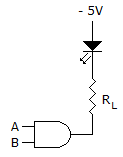Digital Electronics - Integrated-Circuit Logic Families
Exercise : Integrated-Circuit Logic Families - General Questions
- Integrated-Circuit Logic Families - General Questions
- Integrated-Circuit Logic Families - True or False
- Integrated-Circuit Logic Families - Filling the Blanks
26.
What is unique about TTL devices such as the 74S00?
27.
Refer to the figure given below. What type of device is shown and what input levels are required to turn the LED off?

28.
Generally, the voltage measured at an unused TTL input would typically be measured between:
29.
The IEEE/ANSI notation of an internal underlined diamond denotes:
30.
The bipolar TTL logic family that was developed to increase switching speed by preventing transistor saturation is:
Quick links
Quantitative Aptitude
Verbal (English)
Reasoning
Programming
Interview
Placement Papers